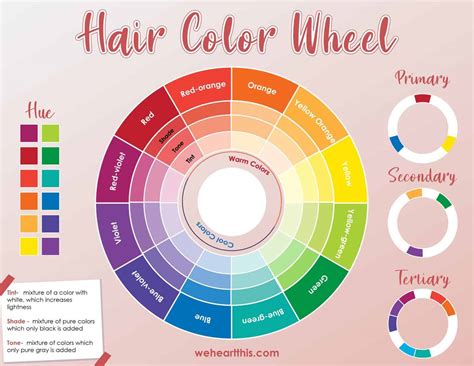Understanding the Color Wheel
The color wheel is a tool that helps colorists and hairstylists visualize the relationships between different hair colors. It is divided into 12 main colors:

- Primary colors: Red, blue, and yellow
- Secondary colors: Green, orange, and purple (created by mixing two primary colors)
- Tertiary colors: Yellow-green, blue-green, red-orange, red-violet, blue-violet, and yellow-orange (created by mixing a primary and a secondary color)
Choosing the Perfect Hair Color
To choose the perfect hair color, you need to consider your skin tone, eye color, and personal style.
Skin Tone:
- Fair skin: Best with cool colors like ash blonde, silver, or platinum.
- Medium skin: Can wear a wider range of colors, from warm (auburn, copper) to cool (caramel, chocolate).
- Olive skin: Suits warm colors like golden blonde, brown, and chestnut.
- Dark skin: Can pull off any color, but particularly striking with bright colors like red, purple, or blue.
Eye Color:
- Brown eyes: Can wear most colors, but especially flatter with warm shades like copper, gold, or mahogany.
- Blue eyes: Look best with cool colors like ash blonde, platinum, or icy blue.
- Green eyes: Enhanced by warm colors like copper, gold, or red.
- Hazel eyes: Can wear a wide variety of colors, but especially flattering with reddish-brown, hazel, or blonde.
Personal Style:
- Natural: Best with colors close to your natural hue, such as brown, blonde, or red.
- Edgy: Experiment with bright colors like blue, green, or purple.
- Conservative: Stick with classic colors like brown, black, or blonde.
- Fun-loving: Try playful colors like pink, orange, or blue.
Professional Hair Dyeing vs. At-Home Dyeing
Professional Hair Dyeing:
-
Benefits:
- Controlled environment
- Expert guidance
- High-quality products
-
Drawbacks:
- More expensive
- Can be time-consuming
At-Home Dyeing:
-
Benefits:
- Convenient
- Affordable
- Faster
-
Drawbacks:
- Difficult to achieve salon-quality results
- Potential for damage to hair
Table 1: Skin Tone and Flattering Hair Colors
| Skin Tone | Recommended Hair Colors |
|---|---|
| Fair | Ash blonde, silver, platinum |
| Medium | Caramel, chocolate, auburn, copper |
| Olive | Golden blonde, brown, chestnut |
| Dark | Red, purple, blue |
Table 2: Eye Color and Flattering Hair Colors
| Eye Color | Recommended Hair Colors |
|---|---|
| Brown | Copper, gold, mahogany |
| Blue | Ash blonde, platinum, icy blue |
| Green | Copper, gold, red |
| Hazel | Reddish-brown, hazel, blonde |
Table 3: Pros and Cons of Professional Hair Dyeing and At-Home Dyeing
| Method | Pros | Cons |
|---|---|---|
| Professional Hair Dyeing | Controlled environment, expert guidance, high-quality products | More expensive, time-consuming |
| At-Home Dyeing | Convenient, affordable, faster | Difficult to achieve salon-quality results, potential for hair damage |
Table 4: Common Hair Color Mistakes
| Mistake | Consequences |
|---|---|
| Using the wrong color wheel | Can lead to unflattering or unwanted results |
| Applying hair dye incorrectly | Can cause scalp irritation or hair damage |
| Over-processing hair | Can make hair brittle and more prone to breakage |
| Not maintaining hair color | Can lead to fading or dullness |
FAQs
- Can I change my hair color myself?
Yes, but it is recommended to consult a professional hairstylist if you are unsure of the process or have complex color goals.
- How long does hair dye last?
Permanent hair dye can last for several months, while semi-permanent and temporary dyes typically fade within a few weeks.
- Can I dye my hair over bleach?
Yes, but it is important to use a color that is specifically designed for bleached hair to avoid damage.
- What are the latest hair color trends?
Some of the latest hair color trends include balayage, ombre, and underlights.
- How can I protect my colored hair?
Use color-protecting shampoos and conditioners, avoid heat styling, and limit sun exposure.
- What should I do if I am unhappy with my hair color?
If you are unhappy with your hair color, consult a professional hairstylist as soon as possible to correct it.
